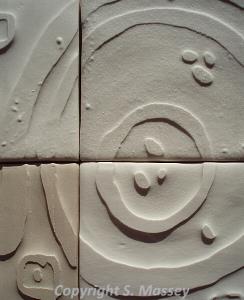
Detail of a ceramic dish by Sarah Massey. (© S. Massey.)
The ceramics I have produced all make reference to archaeological sites in the design, technique and finished form. The designs are inspired by the plan and pattern of archaeological sites, in particular how they appear in aerial photographs or excavation plans. I think that the patterns, colours and texture visible on aerial photographs and on excavations lend themselves particularly well to artistic representation.

Detail of ceramic tiles by Sarah Massey. (© S. Massey.)

Ceramic ball by Sarah Massey. (© S. Massey.)
Some of the ceramic designs involve exact representations of the archaeological sites, such as the complex series of cropmarks at Hopton-on-Sea, where a late prehistoric settlement and fields (NHER
43494) appear to have been overlain with a planned Roman field system (NHER
43495). Here the contrasting plans and organisation of the sites clearly reveal the level of social and temporal change that this has taken place. Many of the other pieces are more loosely inspired by the types of archaeological features recorded from aerial photographs during the work of the Norfolk NMP project. The ditches of many features are characteristically irregular, often due to the feature being recut over time, and it is this fluidity of line and the blurring of the edge that I like to try and recreate in clay.

Ceramic dish by Sarah Massey. (© S. Massey.)
I have also tried to employ particular methods in creating my ceramics that mimic archaeological techniques or processes. Two of the pieces illustrated below have inlaid design. This involves carving into the wet clay a pattern and then filling the resulting groove with another coloured clay or slip. The surface of the clay is then scraped back to reveal the outline of the design. The act of scraping the clays back to the original surface is extremely reminiscent of archaeological excavation, when the fills and edges of features are revealed by scraping the surface. Depending on the geology and the nature of the site or deposit, this often involves a degree of feeling the change in material, as well as seeing an obvious change, such as colour. A similar technique has to be employed with scraping the ceramic surface. When producing black inlaid slip decoration on red or terracotta clay, the unfired black slip is often red, almost indistinguishable from the red clay, apart from the feel of the two different materials when scraped.
The other technique I utilise is shellac resist; this involves painting a pattern in shellac varnish on dry, but unfired clay. The surface is then wiped and ground away gradually using a damp cloth. The clay underneath the shellac is protected, whereas the surrounding clay is washed away. Once fired this leaves a smooth design standing proud of an uneven clay surface. Again this technique is reminiscent of archaeological excavation, but even more so of geological processes that creates and defines the landscape. The reaction of particular deposits, both natural and manmade, to water and pressure is fundamental to formation of the landscape as a whole and on a smaller scale to the preservation of archaeological features.

Detail of ceramic tiles by Sarah Massey. (© S. Massey.)
Using this technique I am working on a number of ceramic pieces that are inspired by archaeological cropmarks and earthworks. The recognition of both cropmarks and earthworks on aerial photographs relies on differences in tone, texture and height. These pieces, in contrast to the inlay, emphasise the texture and height aspects. These are created using tiles of different types of clay that are all white or off-white and this base colour was chosen to accentuate the form and relief, as opposed to tonal pattern. Different types of clay were chosen, such as porcelains and stonewares, which would have different textures and would react differently to the shellac resist technique. The division of the pieces into different tiles represents the division of the landscape into fields or areas of different land use. Archaeological features will often show well in one field and not as well in an adjoining field, due to a different crop or landuse. The relief created by the ceramic surfaces again emphasises the importance of shadow in recognising archaeological earthworks. The long shadows created by the low sun in winter can highlight extremely ephemeral and previously unnoticed earthworks. The character of the ceramics change dramatically in response to the intensity and angle of the light.

Shadows highlighting relief designs on ceramic tiles by Sarah Massey. (© S. Massey.)
Sarah can be contacted at:
sarah.massey@norfolk.gov.uk
Prehistoric field systems, Hopton - NHER 43494 and 43495